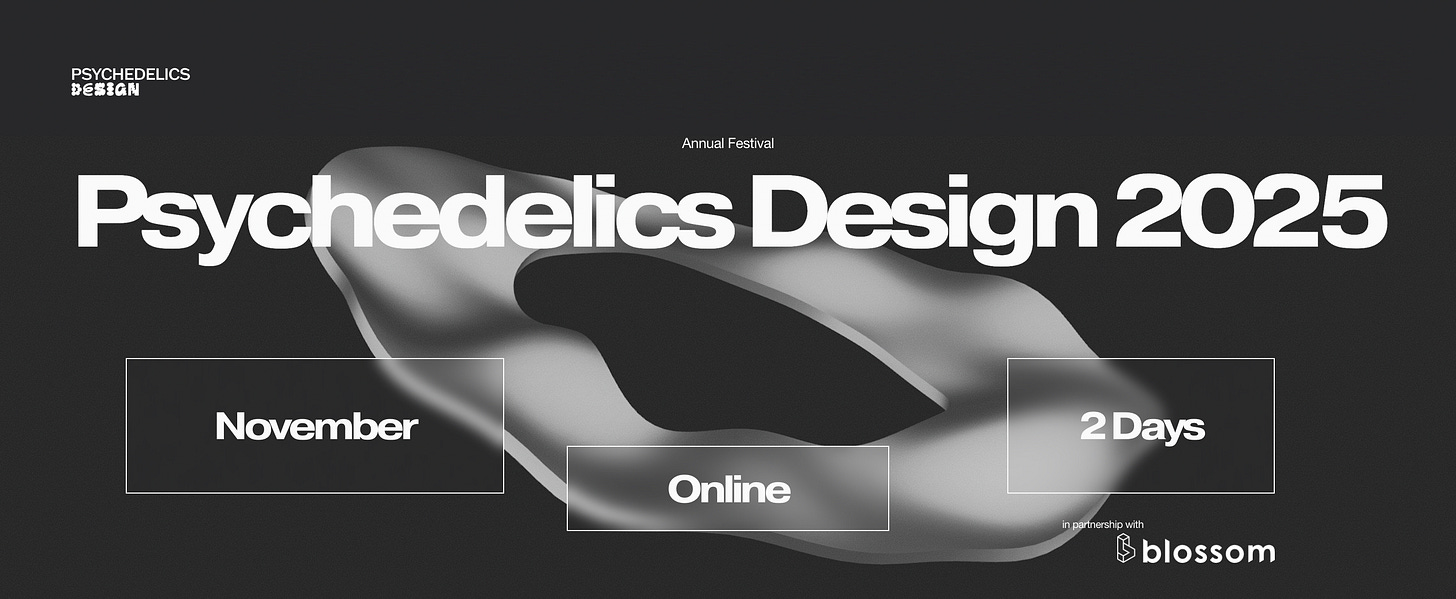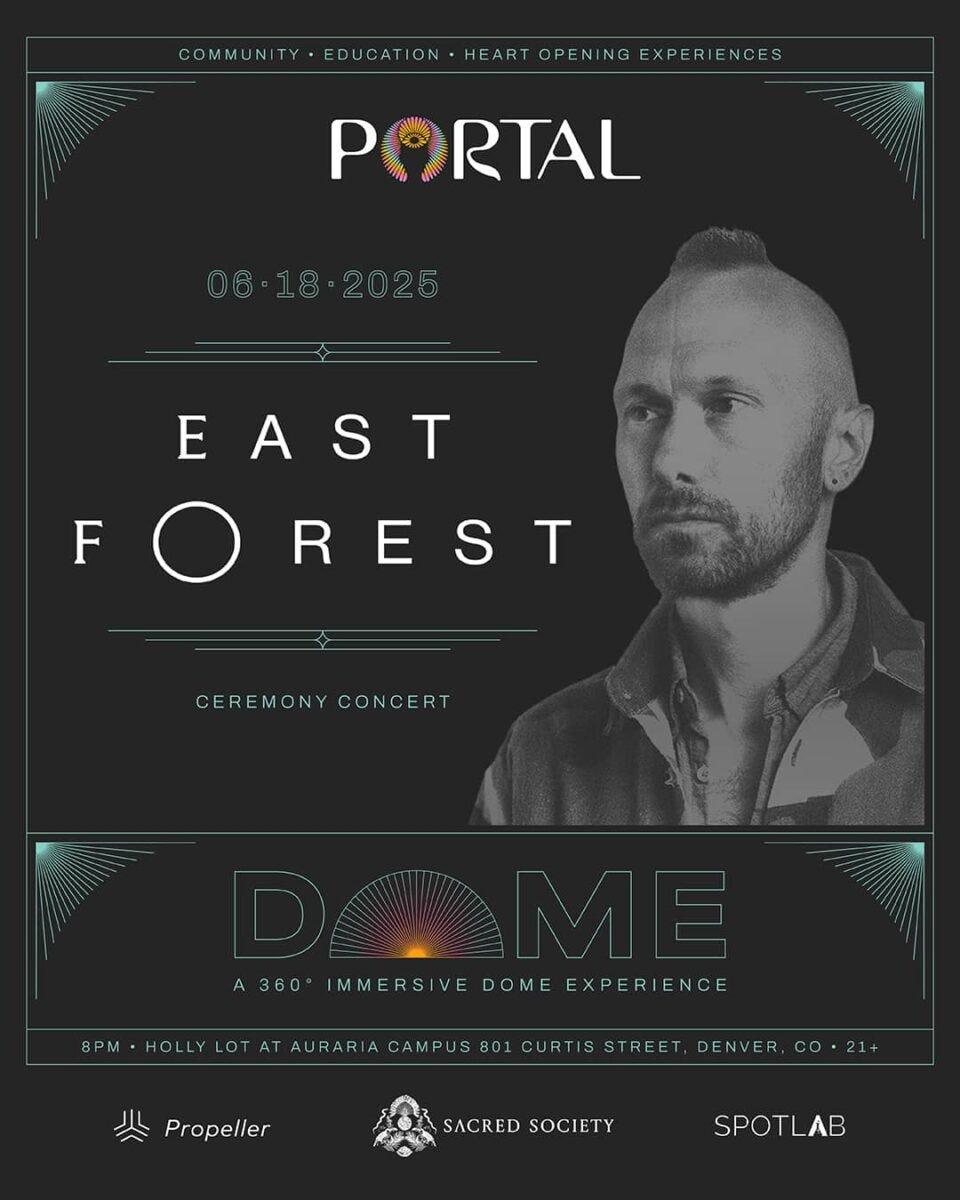Design as Presence
From method to mysticism — a new vision for creative thinking
Welcome to Psychedelics Design – where design meets psychedelics!
Can we design more deeply by thinking more wildly?
Before we reimagine Design Thinking, let’s ground ourselves:
Design Thinking is a creative problem-solving process that prioritizes human needs. It typically unfolds in five stages—Empathize, Define, Ideate, Prototype, Test—encouraging teams to understand users deeply, generate bold ideas, and iterate quickly. It’s widely used in design, business, and social innovation.
But what if this method didn’t just involve the mind, but also the expanded mind?
What happens when this structured process meets the boundary-dissolving, insight-generating qualities of psychedelic experience?
The answer: something radically reimagined.
INTRODUCING
Psychedelic Alpha, independent data-driven reporting, analysis and commentary on the psychedelics space: from business and drug development through to policy reform and culture.
https://www.linkedin.com/posts/joshhardmanuk_500-papers-30-researchers-experts-activity-7328407813603405825-Xu2B?utm_source=share&utm_medium=member_ios&rcm=ACoAAAXxdYMBw9XiMIUopr6AfyjVxdZsZ8X0y84
The Psychedelic is the Interface
Design Thinking has shaped the way we solve problems. It's helped us ask better questions, listen more deeply, and build with real human needs in mind. We respect it—for its clarity, its accessibility, its track record of impact.
But what if there's more?
What if the framework is just a doorway?
What if creativity lives not only in process, but in presence?
Not only in steps, but in states?
This issue isn't a critique of Design Thinking. It’s an invitation to expand it. To hold it. To infuse it with something less linear, more alive—intuition, imagination, and altered awareness.
“Design creates culture. Culture shapes values. Values determine the future." – Robert L. Peters
What Is Design Thinking?
Design Thinking is a human-centered, iterative approach to solving complex problems. It’s a process that typically flows through five stages:
Empathize – understand people in their context
Define – frame the core need or challenge
Ideate – generate a wide range of ideas
Prototype – make quick, tangible versions
Test – learn by observing real reactions
Popularized by IDEO and taught around the world, Design Thinking is powerful because it brings structure to creativity. It reminds us to start with people, stay open, and keep learning.
But even the most useful frameworks can become rigid if we forget to stay fluid within them.
In her bold talk, Natasha Jen famously challenged the culture of Design Thinking, calling out its over-reliance on shallow rituals like Post-it notes and empathy maps. Her point wasn’t to destroy the method—it was to bring back rigor, critical thinking, and creative depth.
We’d add: it’s also time to bring back mystery.
Altered States
Psychedelics and non-ordinary states of consciousness—through plants, breathwork, meditation, even intense play—invite us into different ways of knowing. They don’t follow a five-step path. They dissolve paths. They deepen presence.
Where Design Thinking offers structure, altered states offer surrender.
And the most compelling design often comes from the tension between the two.
Let’s explore how the stages of Design Thinking might unfold when expanded by intuition, sensation, and altered perception.
“Creativity is intelligence having fun.” – Albert Einstein
🌿 EMPATHIZE → Become the Other
Design Thinking begins with empathy. Listening, observing, understanding.
In altered states, that boundary between self and other can dissolve. This isn’t empathy as analysis—it’s empathy as immersion. Designers report feeling not just what users feel, but entering their world, even their body, as if from the inside out.
“I didn’t try to imagine their experience. I became it.”
Empathy, here, isn’t a task. It’s a shift in being.
💡 IDEATE → Follow the Wild Thread
Ideation is about openness—about quantity, divergence, risk.
In altered states, ideas don’t come from effort. They arise from unexpected places: symbols, dreams, memories, music. The subconscious becomes a collaborator. Logic loosens. Intuition sharpens.
“The idea came not as a thought, but as a color. A movement. I followed it.”
This isn’t about brainstorming harder. It’s about listening more deeply—to the body, to the room, to the silence between thoughts.
🛠 PROTOTYPE → Play with Reverence
Design Thinking encourages rapid prototyping: low-fidelity, low-attachment.
Through a psychedelic lens, prototyping becomes ritual. It’s still quick, but it’s more embodied. There’s reverence in the making. A sense that materials carry meaning. That what we build isn't just a test—it's a transmission.
The prototype isn’t a rough draft. It’s a whisper from the future.
This doesn’t slow us down. It changes how we relate to what we make.
🧪 TEST → Sense the Resonance
Testing usually means gathering feedback, refining, iterating.
But feedback isn’t just verbal. It’s vibrational. Altered states can tune us into subtleties—a gesture, a breath, a pause in the room. You begin to sense whether something lands before a word is spoken.
“I could feel whether it was right. Not in my head—in my chest.”
Testing, in this frame, is less about validation. More about attunement.
From Framework to Flow
This isn’t about abandoning process.
It’s about remembering that process is not the point. Presence is.
Design Thinking has given us incredible tools.
Now, we’re exploring how to infuse those tools with more aliveness—
More mystery. More intuition. More embodied awareness.
Not Post-its alone. But patterns, dreams, and deeper listening.
Not “how do we solve this problem?”
But “what is this problem asking us to become?”
Not just empathy for users.
But empathy for the system, the future, the unseen.
A Practice, Not a Process
Design, at its heart, is a relational act.
A practice of connecting what wants to emerge with what needs to be made.
Frameworks like Design Thinking help us focus.
But it’s our capacity to feel, to trust, and to not-know that allows the deepest work to surface.
So let’s keep the steps. But hold them loosely.
Let’s honor the method. And step beyond it, when it’s time.
Let’s let the wild back in.
NEXT UP
The Annual Psychedelics Design Festival is in the making
This is your chance to talk at the Psychedelics Design 2025 Conference, where design, culture, creativity, psychedelics, and business converge.
Submissions Open
Submit here: https://forms.gle/RfhRpeNNmCF3VRpy6
Final Submission Deadline
10 June 2025
Notifying Successful Applicants
July 2025
RECENT NEWS
Frontiers AI & Psychedelic Cognition Paper
A new article explores parallels between psychedelic‑induced cognitive disruptions (e.g., reduced latent inhibition, increased divergent thinking) and how AI might mimic those processes to spark novel associations. It reinforces the view that psychedelics rewire the Default Mode Network to unlock creativity.
Harvard’s Psychedelic Intersections
Harvard’s CSWR recently convened scholars on psychedelic chaplaincy, Indigenous plant traditions, and art/aesthetics—underscoring creativity as both intellectual and spiritual practice.
AP News on Microdosing
A recent AP report finds that while many microdosers claim enhanced creativity and presence, rigorous placebo‑controlled trials so far show no sustained creativity gains beyond expectation effects—and any acute boosts may largely reflect belief rather than pharmacology.
FROM OUR PARTNERS
East Forest IN THE PORTAL DOME
The PORTAL Dome is an intimate, 360° projection dome for music, film, conversation & consciousness during Psychedelic Science 2025 in Denver from June 14-22.
Known for his transformative live performances, East Forest will create an immersive musical experience that is the perfect soundtrack to a deep personal journey and this is your chance to see it in a 360 full dome setting. Other events at the Dome will be with Snow Raven and a Meow Wolf takeover!






